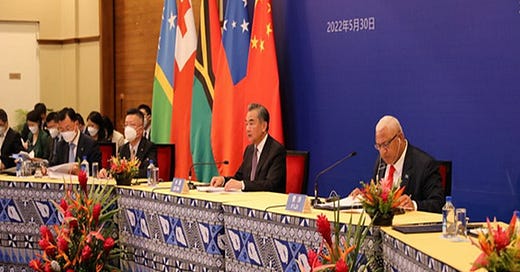China’s Pacific Islands Position Paper Debunks Fake News Claims
What’s most significant about this document is that it represents a new model of international cooperation, especially between asymmetrically sized countries.
The Chinese Foreign Ministry released a position paper on the country’s relations with the ten Pacific Island Countries (PICs) that have diplomatic relations with Beijing. It comes as Foreign Minister Wang Yi wraps up his regional sojourn that saw him interacting with many of his counterparts and their other representatives. His trip was decried by American, Australian, and other Western media as supposedly signaling some sort of imperialist intentions on China’s part, yet the position paper debunks all of that.
The overarching theme of the document is China’s desire to build a community of shared future with the PICs, which is consistent with its grand strategy that it aims to advance via the Belt & Road Initiative (BRI) and other forms of mutually beneficial cooperation. To that end, China is very considerate of its partners’ concerns, which is why it promises to treat them with the utmost of respect. This stands in stark contrast to how the US-led West mistreats comparatively smaller-sized countries.
For instance, the first three points of this 15-point position paper reaffirm China’s respect for the PICs role as equal partners in the eyes of international law despite the asymmetries in their size. It acknowledges their independence, territorial integrity, and shared desire to continue their economic development with a view towards improving their people’s lives. Another commonality between all parties is to ensure security and stability without doing so at anyone else’s expense.
Importantly, the last part of the third point talks about upholding the non-proliferation regime and respecting the region’s non-nuclear status. This can be interpreted as a response to the Australia-UK-US (AUKUS) military alliance that will violate the former by sharing nuclear technology with Canberra and which also risks violating the latter if nuclear-powered and/or -armed submarines attempt to transit through the PICs’ maritime territory.
Points 4-6 then detail the broad parameters of China’s envisioned economic cooperation with its regional partners. This includes BRI cooperation, special economic zones, new multilateral economic initiatives, and trade expos. Expanding access to China’s massive market for the PICs’ agricultural products is also mentioned, which will help develop this industry that’s so important for their national economies. Of course, it’s also implied that China will help them diversify their economies, too.
From there, points 7-10 cover marine, medical, and people-to-people cooperation, including in the cultural and educational spheres. This includes improving disaster warning capabilities, fighting COVID-19, supporting women and children, establishing Confucius Institutes, and providing scholarships to regional students. Points 11-14 are more multilateral and involve the Paris Agreement, cooperation within the UN, Agenda 2030, and potential tripartite cooperation with the PICs.
The 15th and final point elaborates on the mechanisms for bilateral cooperation between China and the PICs. Its 24 subpoints are comprehensive and cover every practical sphere of relations between these countries. They can essentially be interpreted as the means through which China envisions achieving the 14 prior points enumerated in its position paper. This shows that the People’s Republic is sincere in delivering on this ambitious vision of creating a community of shared future with the PICs.
What’s most significant about this document is that it represents a new model of international cooperation, especially between asymmetrically sized countries. China is a big country while the PICs are obviously much smaller. Nevertheless, Beijing has absolutely zero imperialist intentions towards them. To the contrary, it’s willing to continue investing in its partners’ capabilities, economies, and societies in order to improve their people’s lives over the long term, which aligns with China’s grand strategy.
The contrast between China’s approach to the PICs and Australia’s, the US’, and other Western countries’ is undeniable and thus debunks the latter’s false claims that the former has imperialist intentions. Moreover, by publishing such an ambitious document that reaffirms international law as enshrined in the UN Charter, China is implying that this new model of cooperation can become the standard for all responsible countries going forward, especially big ones like those in the West.
They’re unlikely to follow its lead, however, since it’s their intentions that have always been imperialist, never China’s. In a desperate attempt to distract the global public from this factual observation, their politicians and perception managers in the Mainstream Media have attempted to gaslight by misportraying China as the imperialist one even though that’s not true whatsoever at all as proven by its position paper on mutual respect and common development with the PICs.




